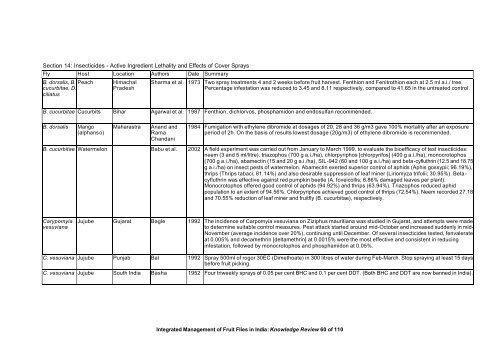“Key Informant Survey” of Production, Value, Losses and ... - DfID
“Key Informant Survey” of Production, Value, Losses and ... - DfID
“Key Informant Survey” of Production, Value, Losses and ... - DfID
You also want an ePaper? Increase the reach of your titles
YUMPU automatically turns print PDFs into web optimized ePapers that Google loves.
Section 14: Insecticides - Active Ingredient Lethality <strong>and</strong> Effects <strong>of</strong> Cover Sprays<br />
Fly Host Location Authors Date Summary<br />
B. dorsalis, B.<br />
cucurbitae, D.<br />
ciliatus<br />
Peach Himachal<br />
Pradesh<br />
Sharma et al. 1973 Two spray treatments 4 <strong>and</strong> 2 weeks before fruit harvest. Fenthion <strong>and</strong> Fenitrothion each at 2.5 ml a.i./ tree.<br />
Percentage infestation was reduced to 3.45 <strong>and</strong> 8.11 respectively, compared to 41.65 in the untreated control.<br />
B. cucurbitae Cucurbits Bihar Agarwal et al. 1987 Fenthion, dichlorvos, phosphamidon <strong>and</strong> endosulfan recommended.<br />
B. dorsalis Mango<br />
(alphanso)<br />
Maharastra An<strong>and</strong> <strong>and</strong><br />
Rama<br />
Ch<strong>and</strong>ani<br />
1984 Fumigation with ethylene dibromide at dosages <strong>of</strong> 20, 28 <strong>and</strong> 36 g/m3 gave 100% mortality after an exposure<br />
period <strong>of</strong> 2h. On the basis <strong>of</strong> results lowest dosage (20g/m3) <strong>of</strong> ethylene dibromide is recommended.<br />
B. cucurbitae Watermelon Babu et al. 2002 A field experiment was carried out from January to March 1999, to evaluate the bioefficacy <strong>of</strong> test insecticides:<br />
neem (3 <strong>and</strong> 5 ml/litre), triazophos (700 g a.i./ha), chlorpyriphos [chlorpyrifos] (400 g a.i./ha), monocrotophos<br />
(700 g a.i./ha), abamectin (15 <strong>and</strong> 20 g a.i./ha), SIL-942 (60 <strong>and</strong> 100 g a.i./ha) <strong>and</strong> beta-cyfluthrin (12.5 <strong>and</strong> 18.75<br />
g a.i./ha) on insect pests <strong>of</strong> watermelon. Abamectin exerted superior control <strong>of</strong> aphids (Aphis gossypii; 96.19%),<br />
thrips (Thrips tabaci; 81.14%) <strong>and</strong> also desirable suppression <strong>of</strong> leaf miner (Liriomyza trifolii; 30.95%). Betacyfluthrin<br />
was effective against red pumpkin beetle (A. foveicollis; 6.86% damaged leaves per plant).<br />
Monocrotophos <strong>of</strong>fered good control <strong>of</strong> aphids (94.92%) <strong>and</strong> thrips (63.94%). Triazophos reduced aphid<br />
population to an extent <strong>of</strong> 94.56%. Chlorpyriphos achieved good control <strong>of</strong> thrips (72.54%). Neem recorded 27.18<br />
<strong>and</strong> 70.55% reduction <strong>of</strong> leaf miner <strong>and</strong> fruitfly (B. cucurbitae), respectively.<br />
Carypomyia<br />
vesuviana<br />
Jujube Gujarat Bagle 1992 The incidence <strong>of</strong> Carpomyia vesuviana on Ziziphus mauritiana was studied in Gujarat, <strong>and</strong> attempts were made<br />
to determine suitable control measures. Pest attack started around mid-October <strong>and</strong> increased suddenly in mid-<br />
November (average incidence over 20%), continuing until December. Of several insecticides tested, fenvalerate<br />
at 0.005% <strong>and</strong> decamethrin [deltamethrin] at 0.0015% were the most effective <strong>and</strong> consistent in reducing<br />
infestation, followed by monocrotophos <strong>and</strong> phosphamidon at 0.05%.<br />
C. vesuviana Jujube Punjab Bal 1992 Spray 500ml <strong>of</strong> rogor 30EC (Dimethoate) in 300 litres <strong>of</strong> water during Feb-March. Stop spraying at least 15 days<br />
before fruit picking.<br />
C. vesuviana Jujube South India Basha 1952 Four triweekly sprays <strong>of</strong> 0.05 per cent BHC <strong>and</strong> 0.1 per cent DDT. (Both BHC <strong>and</strong> DDT are now banned in India).<br />
Integrated Management <strong>of</strong> Fruit Flies in India: Knowledge Review 60 <strong>of</strong> 110

















